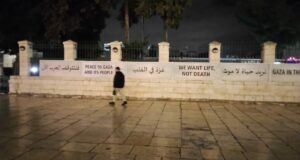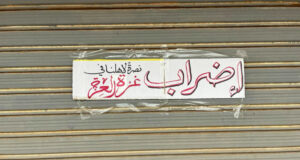International Solidarity Movement
23rd May 2010

Soldiers tried to force demonstrators back from a blocked entrance to Shuhada Street
Approximately 100 people joined the demonstration which gathered at a military barrier which blocks one of the entrances to Shuhada Street from the Old City. After an hour or so of speeches, chants and songs, and the distribution of numerous boycott ‘contracts’, which ask people to commit themselves to boycotting settlement products, the demonstrators marched through the Old City to a second blocked entrance, from which soldiers tried to force them back. The march continued, stopping at the Palestinian Authority Municipal Inspectors office, which the Israelis closed last week, in a direct contravention of the Oslo Accords (1994). As protesters moved through the Old City, settlers in the floors above poured water and threw eggs at them.
The settlements in Hebron are, like all settlements within the West Bank and East Jerusalem, illegal under international law. Palestinian residents of the Old City and the district of Tel Rumeida suffer severe restriction of movement, frequent harassment and occasional violence at the hands of both soldiers and settlers. Shuhada Street has been closed to Palestinians since 1994, forcing shops to close and residents to leave their homes.
ISM Journal: A visit to Hebron

Wadiya and Fadeh
Fadeh’s problem is that his house is situated in an area of the city which Jewish settlers have, since 1967, progressively infiltrated. Called by them “Beit Hadassah”, the neighbourhood is now home to some of the most rabidly racist settlers in the West Bank. They occupy upper floor apartments from which they have forcibly expelled the Palestinian owners. From here they have been known to throw rubbish, rocks, urine and faeces down onto passers by.
Constant aggression and physical attacks are tactics employed by the settlers to force more Palestinians to leave the neighbourhood. Fadeh himself was shot four times during an invasion of his house. His nephew Wadiya (6) still bears the scar on his face of a recent rock attack. As a four-year-old he was abducted by settlers and was later found unconscious, with traces of a chlorine-like substance around his eyes.
Sometimes the settlers adopt less violent methods of persuasion. Fadeh has been offered in excess of AUD$1,000,000 for his modest house. This ties in with reports of other Palestinians being offered similar sums for their strategically-placed properties, together with the offer of resettlement in the United States. While this may seem far-fetched it is worthwhile remembering that a proportion of the settlement activity on the West Bank, and in particular in Hebron, is financed by American Jewish billionaires sympathetic to the Zionist enterprise.
Complaining to the Israeli police, who have jurisdiction in this part of the city, is useless. When he complained about the storefronts which had been welded shut, Fadeh was told by a captain of police, “This area will remain closed until the death of the Palestinian state”. Such is life in Occupied Hebron.
 International Solidarity Movement Nonviolence. Justice. Freedom.
International Solidarity Movement Nonviolence. Justice. Freedom.


